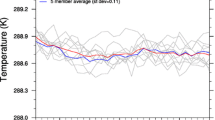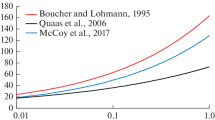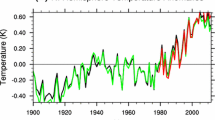Abstract
The indirect effects of anthropogenic sulfate aerosols on the albedo and lifetime of clouds may produce a significant impact on the climate system. A `state of the art' general circulation model (GCM) which includes an interactive sulfur cycle and a physically based cloud microphysics scheme is coupled to a mixed-layer ocean model in order to study the impact of the indirect effects on the coupled climate system. The linearity of the two indirect effects on the model response is also investigated by including each effect separately in the model. The response of the sea surface temperatures (SSTs) and sea ice is found to provide an important feedback on the cooling at high latitudes and the change in meridional SST gradient results in a southward shift of the inter-tropical convergence zone (ITCZ). The sensitivity of the model to the forcing from the indirect effects of sulfate aerosol is found to be similar to, but slightly weaker than that obtained from a doubling of CO2.
Similar content being viewed by others
Author information
Authors and Affiliations
Additional information
Received: 30 August 2000 / Accepted: 3 January 2001
Rights and permissions
About this article
Cite this article
Williams, K., Jones, A., Roberts, D. et al. The response of the climate system to the indirect effects of anthropogenic sulfate aerosol. Climate Dynamics 17, 845–856 (2001). https://doi.org/10.1007/s003820100150
Issue Date:
DOI: https://doi.org/10.1007/s003820100150




